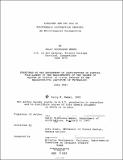| dc.contributor.advisor | Otto Piene. | en_US |
| dc.contributor.author | Weber, Sally Nicholson | en_US |
| dc.contributor.other | Massachusetts Institute of Technology. Dept. of Architecture. | en_US |
| dc.date.accessioned | 2009-04-29T17:04:39Z | |
| dc.date.available | 2009-04-29T17:04:39Z | |
| dc.date.copyright | 1983 | en_US |
| dc.date.issued | 1983 | en_US |
| dc.identifier.uri | http://hdl.handle.net/1721.1/45180 | |
| dc.description | Thesis (M.S.V.S.)--Massachusetts Institute of Technology, Dept. of Architecture, 1983. | en_US |
| dc.description | MICROFICHE COPY AVAILABLE IN ARCHIVES AND ROTCH | en_US |
| dc.description | Bibliography: leaves 73-74. | en_US |
| dc.description.abstract | The movement of sunlight within a building establishes a temporal relation to the spatial structure. Early civilizations aligned buildings with the sun to designate specific calendar days. Gothic and Renaissance cathedrals employed the transient movement of sunlight to activate the interiors with continually varying qualities of light. Light illuminates surfaces, but it is also a material with specific, perceivable qualities. Holographic materials diffract light. Focalpoint, a water fountain installation, incorporated holographic diffraction grating to diffract and focus sunlight as an environmental installation which distinguished the sun's temporal progression with color variations throughout the day. Holographic diffraction grating is a material with the potential to integrate solar energy and architectural design concerns through the focused projection of color into an environment. | en_US |
| dc.description.statementofresponsibility | by Sally Nicholson Weber. | en_US |
| dc.format.extent | 74 leaves | en_US |
| dc.language.iso | eng | en_US |
| dc.publisher | Massachusetts Institute of Technology | en_US |
| dc.rights | M.I.T. theses are protected by
copyright. They may be viewed from this source for any purpose, but
reproduction or distribution in any format is prohibited without written
permission. See provided URL for inquiries about permission. | en_US |
| dc.rights.uri | http://dspace.mit.edu/handle/1721.1/7582 | en_US |
| dc.subject | Architecture. | en_US |
| dc.title | Sunlight and the use of holographic diffraction grating : an environmental perspective | en_US |
| dc.type | Thesis | en_US |
| dc.description.degree | M.S.V.S. | en_US |
| dc.contributor.department | Massachusetts Institute of Technology. Department of Architecture | |
| dc.identifier.oclc | 11504158 | en_US |
